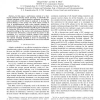Free Online Productivity Tools
i2Speak
i2Symbol
i2OCR
iTex2Img
iWeb2Print
iWeb2Shot
i2Type
iPdf2Split
iPdf2Merge
i2Bopomofo
i2Arabic
i2Style
i2Image
i2PDF
iLatex2Rtf
Sci2ools
119
Voted
VTC
2006
IEEE
2006
IEEE
Performance Analysis of a Rate-Adaptive Dual-Branch Switched Diversity System
Abstract— In this paper, a performance analysis of a dualbranch switched diversity system operating on identically distributed Nakagami-m fading channels is presented. An adaptive coded modulation (ACM) scheme is employed to increase the spectral efficiency of the system. The ACM scheme consists of a set of multidimensional trellis codes originally designed for additive white Gaussian noise channels, where the codes are based on quadrature amplitude modulation (QAM) signal constellations of varying size. The performance is evaluated by assuming perfect channel knowledge at the receiver and instantaneous feedback of channel state information, conveyed from the receiver to the transmitter on a zero-error feedback channel. Both spatially uncorrelated and correlated antenna branches are considered. The optimal switching threshold in terms of maximizing the average spectral efficiency is identified in the case of uncorrelated antenna branches.
Related Content
| Added | 12 Jun 2010 |
| Updated | 12 Jun 2010 |
| Type | Conference |
| Year | 2006 |
| Where | VTC |
| Authors | Bengt Holter, Geir E. Øien |
Comments (0)

